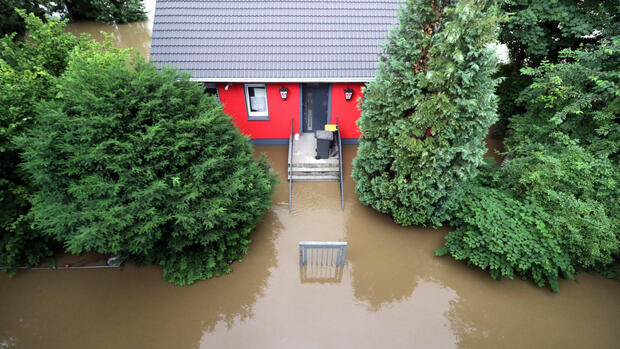Frankfurt, Munich The sharply rising costs could lead to mergers among public insurers. According to the rating agency Fitch, many providers are under increasing pressure to generate earnings. Against this background, small public insurers in particular could be forced to merge and close down.
The public insurers are the silent giants in Germany’s insurance market. If all the insurers in the Savings Banks Finance Group operated under one roof, the annual gross premium income would be 24 billion euros. The insurers of the savings banks would thus be the second largest player in Germany after Allianz and even ahead of Ergo.
But mostly they operate independently. For the Fitch experts, this is not very efficient. The insurers are not making sufficient use of potential synergies, they complain. Instead, they all struggle with the same cost increases and falling margins.
The Fitch experts see major challenges in non-life insurance in particular. Inflation drives up costs, experts speak of “claims inflation”. Building insurance, where public insurers traditionally have a high market share, is particularly affected.
In addition, the reinsurers, with whom the public insurers hedge, have increased their prices sharply. This can only be compensated for slowly. “They can only gradually push through premium increases, especially in private customer business,” says Fitch analyst Christoph Schmitt.
Insurers themselves consider themselves to be in a good position
The public insurers themselves reject the criticism of the rating specialists. “In contrast to Fitch’s opinion, the public insurers certainly expect a gradual compensation for the increased reinsurance premiums through adjustments to the premium level,” according to the Association of Public Insurers (VOEV). The Versicherungskammer Bayern (VKB) – the largest group of companies in the sector – negotiated with reinsurers at an early stage, emphasizes a spokeswoman.
>> Read here: Insurer shares score with increasing dividends
There was also a lack of understanding in Stuttgart at SV Sparkassen Versicherung, the third-largest public insurer in terms of premium income. “We feel we are well positioned in homeowners insurance and in general.”
The public insurers therefore see no pressure to consolidate for the time being. It would have to come from their carriers anyway. For almost all public insurers, these are the savings banks, state banks and regional associations as well as the regional savings banks and giro associations. But here, too, the Fitch criticism is not shared. Instead, as with the Bavarian Savings Banks Association, a sponsor of the VKB, reference is made to a different Fitch rating. This has just given the insurer an excellent rating.
So everything should remain the same, at least in the short to medium term. VKB operates in Bavaria, Berlin, Brandenburg and Saarland. The SV operates in Baden-Württemberg, Hesse, Thuringia and parts of Rhineland-Palatinate.
Provincial based in Münster and VGH Versicherungen from Hanover are primarily represented on the market in the west and north of the country. What at first glance looks like a peaceful division of the German market, however, is also met with criticism away from the big names because of its small-scale nature. According to the Fitch report, there are still 42 public insurers.
Mergers would lead to economies of scale and synergies
This number gives Fitch analysts pause. Because if there were just one company here, it would have “far greater market power,” says Fitch analyst Schmitt. A joint insurer of the German savings banks could achieve higher profitability than the competition.
Because it is precisely the sharply rising costs that are currently burdening the numerous public insurers. According to Fitch, many providers are under increasing earnings pressure. Against this background, small public insurers in particular could be forced to merge and close down.
Particular competitive pressure also comes from the cooperative sector. With R+V Versicherung and DEVK, the Volks- und Raiffeisenbanken have comparatively strong insurers at their side.
>>Read here: Artificial intelligence is revolutionizing insurers
The past shows that consolidation among public insurers is possible. The Versicherungskammer in Bavaria has brought companies together under one roof on several occasions, such as Feuersozität Berlin Brandenburg and Saarland Versicherungen. Elsewhere, after years of trying, the merger of Provincial Northwest and Provincial Rhineland worked. The Fitch experts now expect further cost efficiencies there through the standardization of processes and IT systems.
Insurers cooperate in various areas
Overall, this process should continue, the analysts demand. Mergers between larger providers with premium income of more than EUR 1 billion would increase their geographic diversification and lower capital requirements. An expansion of the business area would also have the advantage of not being hit so hard by regional disasters – such as the provincial by the flood in the Ahr valley.
In the short term, however, even Fitch considers larger mergers to be unrealistic. Schmitt says that merger considerations would go hand in hand with years of politically driven back and forth, as examples from the past have shown.
Nevertheless, he advises the public insurers to appear together as a brand in order to be better perceived by consumers. But they decline. Because of the highly complex ownership structures of the various insurers, even that is difficult to implement, according to the Savings Banks and Giro Association of Hesse-Thuringia.
Instead, the providers rely on mutual support without a merger. At the beginning of last year, for example, they set up a joint natural catastrophe claims pool. In the future, it is intended to cushion damage that a public insurer incurs after a regional natural event, but that goes beyond the existing reinsurance cover.
More: Trend reversal for millions of life insurance policyholders – the year-long decline in interest rates is over
